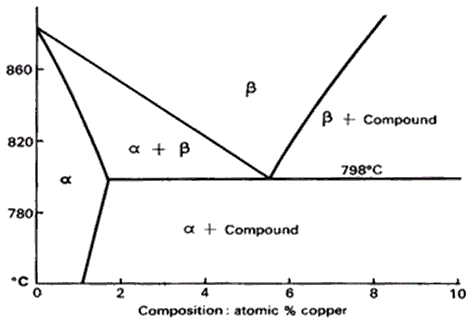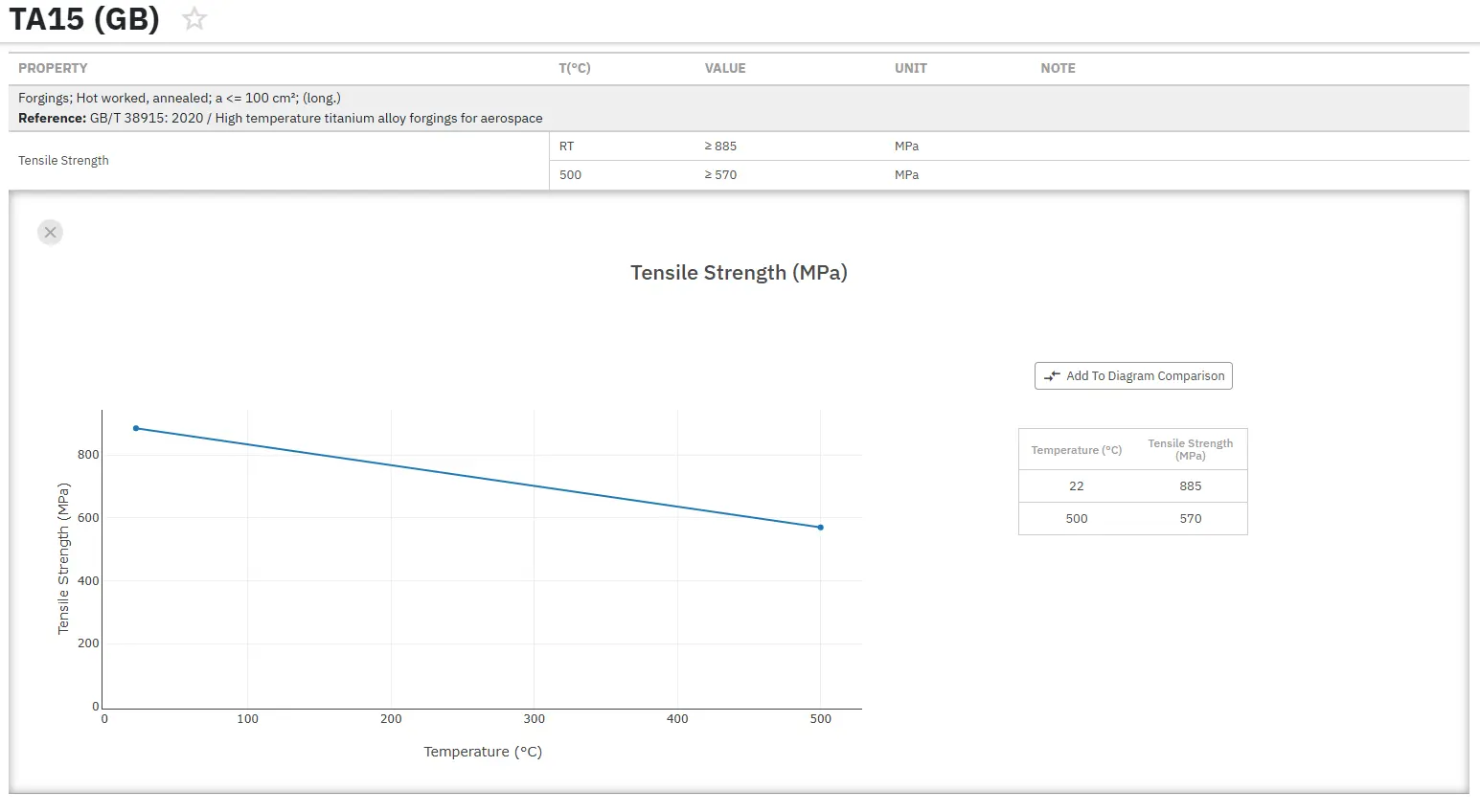Properties and Applications of Titanium – 2.5% Copper Alloy
Abstract
Titanium Alloy Ti-2.5Cu, a binary alloy containing 2.5% copper, combines the formability and weldability of unalloyed titanium with improved mechanical properties, particularly at elevated temperatures. It can be used at temperatures up to 350°C
Titanium Alloy Ti-2.5Cu, a binary alloy containing 2.5% copper, combines the formability and weldability of unalloyed titanium with improved mechanical properties, particularly at elevated temperatures. It can be used at temperatures up to 350°C. Chemical composition of Ti-2.5Cu is given in the Table 1.
Table 1. Chemical composition of Ti - 2.5Cu alloy
| Element | Cu | Fe | H2 | Ti |
| Wt % | 2-3 | ≤ 0.2 | ≤ 0.01 | Remainder |
It has been used since 1959 as sheet, forgings and extrusions for fabricating components such as bypass ducts of gas-turbine engines. In these applications it has been used in the annealed condition, but since 1965 its use has spread to the airframe industry, following the development of an ageing treatment that raises room-temperature tensile properties by about 25% and nearly doubles the elevated-temperature properties (e.g. creep at 200°C). Such a material is particularly attractive since it can be formed in the soft condition, thus lowering fabrication costs.
British Standards TA 21, 22 and 23 refer to sheet, bar and forging stock in the annealed condition. DTD specifications 5233, 5243 and 5253 cover the same three forms of material, but in the ageable or aged condition. A different heat treatment is given to solution-treated material (suitable for ageing) from that for annealed material. It is therefore necessary to decide, before ordering, in which condition it is required. Specifications BS TA 24 and DTD 5263 refer to annealed and aged forgings respectively.
Alloy metallurgy. The diagram for the binary titanium-copper system is shown in Figure 1. The α+β / β transus temperature for a pure Ti-2.5Cu alloy is around 850°C. The difference from the 895°C found in commercial material is due to the oxygen and nitrogen content in the latter.

There is a maximum solid solubility of 2.1 wt% of copper in alpha titanium at 798°C, and about 0.7 wt% at 600°C. This gives the possibility of an age-hardening reaction by precipitation of a compound, Ti2Cu, from a supersaturated alpha solid solution. It is also possible to get age hardening from a martensitic alpha structure, obtained by rapid quenching of the alloy from the beta field, but there is some loss of ductility in this condition.
In material of commercial purity, X-ray diffraction studies indicate that maximum supersaturation of the alpha phase with copper is obtained by solution treatment at 790°C. However, to obtain consistent results under normal production conditions, a solution-treatment temperature of 805 ± 10°C is used.
Decomposition of the supersaturated solid solution occurs, as in all age-hardening systems, by a nucleation-and-growth mechanism. Precipitation is controlled firstly by the number of nuclei available, which decreases with rise in temperature, and secondly by the rate of growth of nuclei by diffusion of copper, which increases with rise in temperature.
Early work indicated that maximum age hardening occurred after treatment at 400°C, but the ageing reaction was very slow and ageing times as long as 140 h were needed to achieve satisfactory response. Higher temperatures produce a more rapid reaction. The optimum combination is an initial treatment of 8-24 h at 400°C to develop the maximum number of well distributed nuclei, followed by further ageing for 8 h at 475°C to give a more rapid growth to the optimum size for maximum strength. This duplex treatment gives a consistent response without risk of over-ageing.
Heat treatment. The full heat treatment consists of solution treatment at 805 ± 10°C followed by a rapid cool and a duplex ageing process of 8-24 h at 400°C and 8 h at 475°C. Many current specifications were evolved at a period when it was thought that 24 h at 400°C was necessary to ensure adequate nucleation. Experience has shown that this is unnecessarily long, and that 8h is quite sufficient. This accounts for the wide tolerance in time (8-24 h) for the first part of the duplex ageing process. All heating may be done in air, provided that normal precautions are taken to restrict contamination by hydrogen.
For sheet, 1/2 h at the solution-treatment temperature is sufficient. Rapid cooling is usually achieved by using a forced air blast, which causes less distortion than a water quench. For thicker sections such as rod, bar, extrusions or forgings, 1 h per 25 mm of section is recommended for thorough heating.
Ageing, for 8-24 h at 400°C and 8 h at 475°C, should be followed by air-cooling in each case. It may be necessary to guard against distortion during the ageing treatment by, for instance, supporting sheet on a flat base or by holding a complex fabrication in a suitable jig. The linear dimensional change on ageing is very small.
On occasions, when subsequent development of the fully aged properties is not necessary, a simple anneal at 790 ± 10°C followed by air cooling is sufficient for both sheet and thicker sections. This treatment may also be used to give a full recrystallisation anneal between heavy cold working operations (e.g. during flow turning).
Stress relieving of annealed material after forming and welding is achieved by a subsequent treatment at 600°C for 5h. For solution-treated material, however, the duplex ageing treatment acts as a satisfactory stress-relieving operation, and the 600°C treatment should not be used since it will cause over-ageing.
The oxide scale formed during annealing or solution treatment should be removed by vapor blasting or other scale-modifying treatment, followed by light pickling in a bath containing 4% commercial hydrofluoric acid and 20% nitric acid in water.
Creep properties. Aged Ti-2.5Cu Alloy (IMI Titanium 230) is more creep-resistant than was IMI Titanium 317 over the range 150-320°C and more creep-resistant than the hardest grade of commercially pure titanium at all temperatures.
It is important that any material whose properties make it technically attractive for operation for long periods at elevated temperatures should be metallurgically and mechanically stable under operating conditions. The room-temperature tensile properties of aged Ti-2.5Cu sheet are not affected by creep exposure for 100 h at temperatures in the range 200-350°C. Slight increase in strength and precipitate particle size is apparent after 5000 h at 350°C but there is no evidence of surface instability or loss of ductility, even though the post-creep tensile tests were carried out with no further surface preparation.
Fatigue properties. Like the steels and most other titanium alloys, Ti-2.5Cu Alloy has a fairly well defined fatigue limit and the S/N curve becomes horizontal at 107 or 108 reversals of stress. The fatigue ratio is particularly good; in most cases, the fatigue limit is more than 0.6 times the static tensile strength.
Forging. Ti-2.5Cu Alloy is very easy to forge. A certain amount of forging in the α+β field is required to develop optimum properties. The ideal forging preheating temperature is 800-820°C, though a preheating temperature of 850°C is commonly used. It may, on occasions, be permissible to go as high as 875°C for initial roughing operations, provided that a reduction of at least 2:1 or 4:1 is subsequently carried out at the lower temperature.
Forming. As the mechanical properties indicate, Ti-2.5Cu Alloy in the annealed or solution-treated condition is capable of undergoing considerable cold deformation without cracking. It is thus amenable to cold forming by conventional methods, such as pressing, stretch forming, spinning, etc., as applied to the stainless steels.
Welding. Ti-2.5Cu Alloy can be joined by fusion, resistance, flash-butt and pressure welding. Fusion welds can be made by both argon-arc and electron-beam welding. Joining techniques are governed by the metal`s affinity for atmospheric gases. At its melting point, titanium rapidly dissolves oxygen, nitrogen, hydrogen and carbon. Oxy-acetylene, metal-arc, carbon-arc and atomic-hydrogen welding processes are therefore unsuitable for titanium.
With adequate control of welding techniques, Ti-2.5Cu Alloy is one of the easiest metals to join. Welds of 100% strength can be obtained, with only a slight loss in tensile or bend ductility. When making a welded fabrication in an age-hardenable alloy such as Ti-2.5Cu Alloy, it is best to carry out the forming and welding on sheet already in the solution-treated condition. Ageing can then be carried out on the fabricated component. If the alloy is to be used in the annealed condition, then welding should be followed by stress relieving for 1/2 h at 600°C.
Uzyskaj dostęp do precyzyjnych właściwości stopów tytanu już teraz! Total Materia Horizon
Total Materia Horizon zawiera informacje o właściwościach tysięcy stopów tytanu: skład, właściwości mechaniczne i fizyczne w różnych temperaturach, właściwości nieliniowe i wiele więcej.

Uzyskaj BEZPŁATNE konto testowe w Total Materia Horizon i dołącz do społeczności ponad 500 000 użytkowników z ponad 120 krajów.